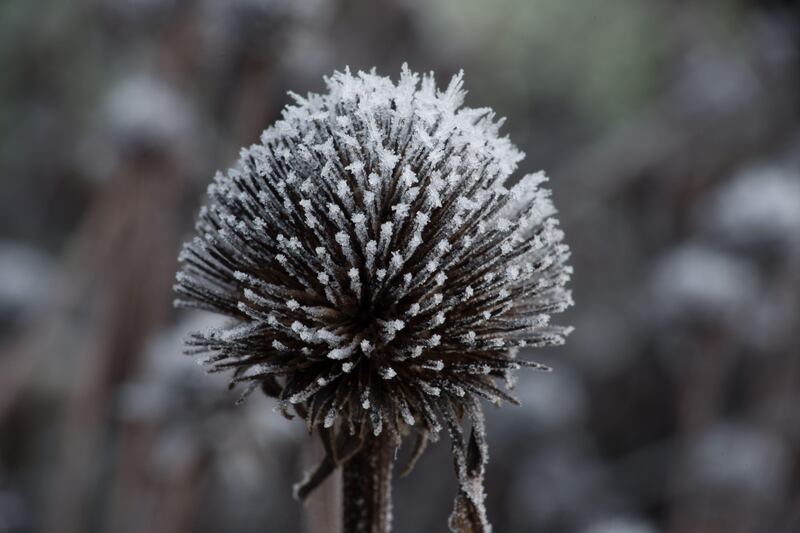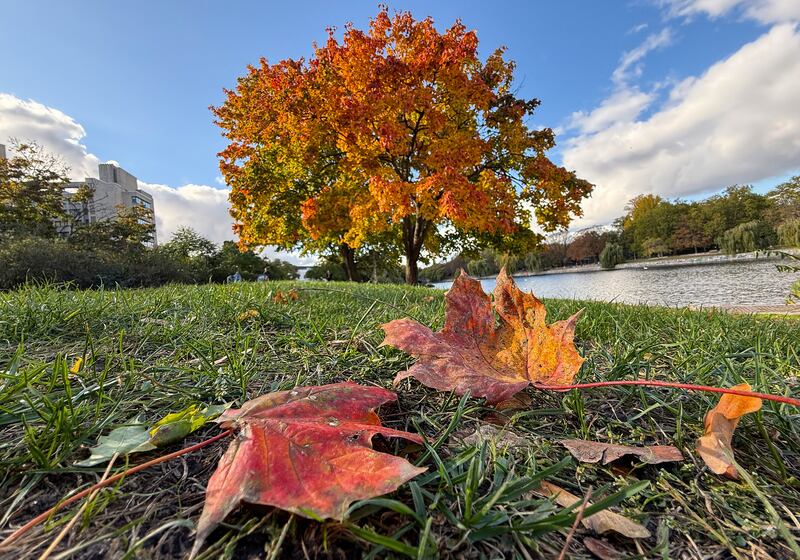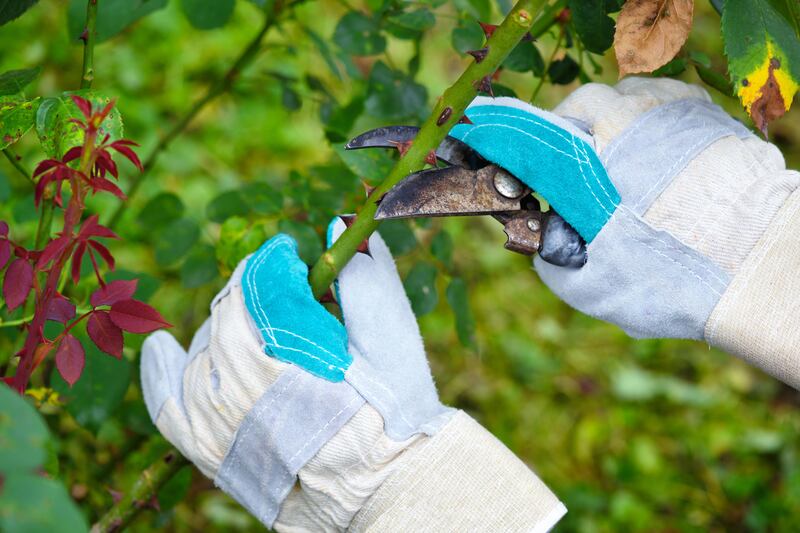As a gardener, it’s hard not to think of the first killing frost of autumn as the thief that comes in the night. This year it arrived particularly early for some – a rude surprise to those who woke up to a drastically changed landscape. One day an abundance of beauty, the next a mess of blackened flowers and foliage, the latter all that remained above ground of any of the half-hardy, frost-tender and subtropical species that fill so many Irish gardens in summer.
That list includes countless varieties of colourful bedding plants such as petunia, surfinia, pelargonium, cosmos, bidens, fuchsia (the tender kinds) and begonia. Statuesque, sun-loving showstoppers too, such as canna, sunflower, dahlia and banana, plus many different kinds of herbs and food crops including dill, basil, tomato, French beans, squash and courgette.

Seeing so much life so abruptly extinguished is always poignant and weirdly shocking, no matter how many years you’ve been gardening. On the other hand, it’s reassuring to bear in mind that those same frosty nights also play a variety of beneficial roles in our gardens and allotments.
One of these – an important one – is to act as a natural curb on the spread of plant pests and diseases. Slugs, for example, are far less active in cold weather, with many species burrowing deep into the soil and/or hibernating as a means of protecting themselves from low temperatures. Likewise, their breeding patterns are dramatically affected, with chilly temperatures below 5 degrees bringing a sharp halt to proceedings as well as preventing any overwintering slug eggs from hatching.
READ MORE

Repeated frosty nights throughout late autumn and winter – the kind of seasonal weather once traditionally experienced in this country – also help to naturally reduce the populations of other common plant pests such as red spider mite and aphids, as well as curtailing the length of their active season by up to several months.
Similarly, those cold autumn and winter temperatures help to kill off the soil-based fungal spores of some destructive diseases. An example is tulip fire (Botrytis tulipae), an increasing problem in many Irish gardens as a result of the unusually mild, wet springs of recent years. Both the flowers and foliage of badly affected plants are disfigured by ugly brown spots and quickly become twisted, withered and distorted. But by holding off from planting the fleshy bulbs until the harsh frosts of autumn and winter arrive to kill this disease’s fungal spores, we can help to reduce the chances of infection. Cold spring weather also helps keep it at bay.
Its role in naturally helping to control pests and diseases aside, cold weather is beneficial in other ways. For certain species of plants, for example, repeated exposure to periods of winter chilling is necessary to break seed dormancy and successfully trigger the process of germination.
[ Tulips, erythroniums and trilliums: aristocratic bulbs for planting seasonOpens in new window ]

Low temperatures do this by gradually breaking down the seed’s hard outer covering as well as causing chemical changes within it, a process known as stratification. By bagging seed in damp sand or vermiculite and then refrigerating it, gardeners can successfully recreate these conditions – but nature does it for us when the conditions are right. For this reason, it’s always worth experimenting by leaving some trays of seed outdoors to let winter do the hard work for us.
Examples of some of the many species that benefit from this chilling period include some of our own native trees such as rowan (Sorbus aucuparia), crab apple (Malus sylvestris), sloe (Prunus spinosa) and hawthorn (Crataegus monogyna) as well as numerous other kinds of decorative hardy annuals, perennials and shrubs from yellow rattle, corncockle and larkspur to aquilegia, lupin, rudbeckia, campanula, magnolia, lilac and witch-hazel.


Exposure to a certain level of winter cold for a period of time is also vital for proper cropping of many kinds of fruiting plants, including apple, pear, peach, fig, plum and strawberry. Known as ‘chill hours’, these help to regulate bud break and blossom time and to initiate the end of winter dormancy. The number of hours required varies, but can be as much as 1,000-1,500 hours at between 5 and 7 degrees. Without it, both growth and flowering become erratic, resulting in plant stress and, crucially, much lower yields – a growing problem through much of Europe because of climate change.
[ Tulips, erythroniums and trilliums: aristocratic bulbs for planting seasonOpens in new window ]
That same exposure to cold autumn and winter temperatures also improves the flavour of certain species of vegetables by developing the starchy sugars within the plant cells. Parsnips, for example, taste more delicious after a winter frost, as do kale and Brussels sprouts.
Operating much like a complicated system of interlocking cogs and wheels, cold autumn and winter weather also helps to regulate other key natural processes in our gardens and allotments, from the timing of leaf fall and vegetal decay to the ways in which soil life functions at a microbial level.


While the fallen leaves and frostbitten plant material of autumn might appear melancholy to us, they both feed and blanket the soil in which our plants grow – a symbiotic relationship of enduring benefit to both. That layer of decaying organic matter is naturally gradually broken down by soil micro-organisms that simultaneously enjoy the protection it provides, their activity subtly raising the temperature of the soil in a way that then helps to protect the root systems of hardy, overwintering species from extremes of winter cold.
So next time you find yourself mourning winter’s icy grip, take a moment to consider the many ways in which it helps to nurture the complex ecosystems and habitats within our gardens and allotments – a delicate balancing act upon which their healthy functioning depends. Because without it, we’d be the poorer.
This week in the garden
- The early harsh frost that hit some parts of the country early this month was a warning sign to gardeners to move certain species of vulnerable half-hardy, tender or subtropical plants under cover of a polytunnel, glasshouse or garden shed to safely overwinter them for reuse next summer. Examples include canna, banana (Musa), pelargoniums, marguerite (Argyranthemum), fuchsia and tender varieties of salvia. In cold and/or wet gardens, dahlias should be cut to the ground and then their fleshy tubers lifted a few weeks later for storing in shallow trays in a cool, dark, dry garden shed.
- That same early harsh frost was a reminder that trays of late summer and early autumn-sown seedlings need a sheltered, protected spot to successfully overwinter. A cool but frost-free glasshouse or polytunnel is ideal, but a cold frame will also work very well as long as it’s kept well-ventilated on sunny days. Failing that, choose a spot in front of a sunny south- or west-facing wall and cover the trays of seedlings with a layer or two of horticultural fleece when hard frosts are forecast.
Dates for your diary
Saturday, November 2nd (10am-4pm), Gloster House & Gardens, Brosna, Birry County Offaly A fundraising event in aid of the Royal Horticultural Society of Ireland (RHSI) takes place with a range of guest speakers including Paul Smyth, head gardener of nearby RHSI Bellefield; John Feehan, author and environmentalist; George Cunningham, author and historian; Tina Claffey, nature photographer. Hosted by Mary and Tom Alexander, the owners of Gloster House, who have done a magnificent job on the restoration of this historic Irish country house and its extensive gardens. Tickets €37, limited availability, see rhsi.ie or Eventbrite.ie for booking, with all proceeds going to the RHSI Bellefield Library Development Fund.














